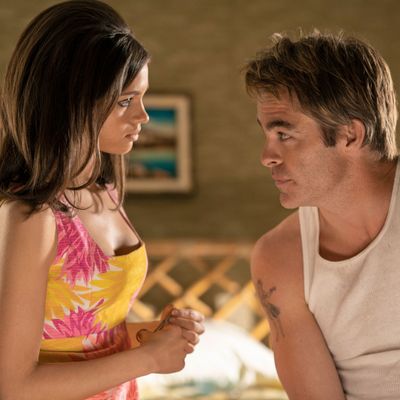
Reality and fiction and theory are blurring on the penultimate episode of TNT’s I Am the Night as Fauna Hodel and Jay Singletary get to Hawaii and find Fauna’s mother, Tamar. It’s worth mentioning up front here that I Am the Night takes a lot of liberties with the true story of the Hodels. Yes, Fauna was a real person, the granddaughter of George Hodel, who was one of the main suspects in the Black Dahlia case. That is all true. Yes, she was given up by her mother Tamar and there were rumors that George was actually Fauna’s father after a high-profile case in 1949. And Tamar did put “Negro” on the birth certificate, leading Fauna to believe she was mixed race until she discovered the truth that she was not. The story of Fauna figuring out her lineage is the mostly true part of I Am the Night; almost everything else is fiction based on some popular true-crime theories.
For example, Chris Pine’s Jay Singletary is not a real person. There was no Korean war vet connecting the dots for Fauna from her dark past to that of the Black Dahlia killer. And so while George Hodel was and still is a major suspect in the case, it’s unlikely a reporter ever sat on a beach in Hawaii and looked at a painting of Elizabeth Short by Hodel, as happens in this episode. And George Hodel was officially not living in the United States when most of I Am the Night takes place (although his son thinks he may have returned now and then). Taking liberties with true stories is perfectly justifiable, but one does wonder how much viewers are taking as history and fiction when they watch I Am the Night. The safest way to look at it is that most of the Fauna story is true, but watch everything else through the filter of creative license.
With that out of the way, “Aloha” is sadly another reminder that there’s a really solid 100-minute movie buried in this six-episode series. If the bulk of the action of this episode were opening the final act of the feature film of this same story, it would have worked better than an episode that feels like it should be thrilling and revelatory, but mostly just reveals things we already knew. We all suspected that the reason Tamar was shuttled off to Hawaii and that Fauna was given to another family was the darkest possibility that she has to come to terms with in the final scenes: that George Hodel is her grandfather and her father. (Back to that record for a second: The real Tamar Hodel did assert that her father had sex with her, but that the resulting pregnancy was terminated and that Fauna’s father was someone else.)
Most of “Aloha” centers on Jay and Fauna heading to Hawaii to find Tamar. The most interesting dramatic undercurrent of the episode comes in Jay’s uncertainty in how to treat Fauna. He doesn’t tell her about the 1949 trial in which Tamar’s father was accused of sexual abuse and Tamar even suggested that he may be the Black Dahlia killer. Nope, he just gets the plane tickets from Peter, rents a slick red convertible, buys some nifty heart-shaped shades, and heads to the coast. Of course, this blows up in his face, and he realizes that he needs to see Fauna as more than just a source. She’s the victim in all of this, the person trying to come to terms with her dark past. He eventually tries to protect her, but only after he realizes that he’s not been considering her emotional journey in the first place.
After a fight at a bar with a drunk sailor and a nice speech for Pine (still easily the best thing about the show) about his war nightmares and the lives he took overseas, Jay and Fauna basically stumble upon Tamar. She has some of the answers that Fauna has been seeking, but it’s not really a closure-providing happy reunion. She only put that on the birth certificate because black people had been nicer to her than white people and she wanted Fauna to grow up with nicer people. And then she drops the bomb that George “made love” to her. Fauna stumbles off, reeling from the implication that Jay had already figured out. George could be Fauna’s father.
Fauna confronts Jay with what he’s been withholding, and he tells Peter he wants to work her out of the story. It’s too late for that. Fauna is the story. Before they leave, Jay finds Tamar by a fire, and she warns him that George is too powerful to topple. He has too many friends. And she shows him paintings that George has been sending her — paintings of Elizabeth Short, Janice Brewster, and his other victims. Creepy.
Back in Los Angeles, Jay goes to Peter, and probably knows as quickly as we do that his buddy has sold him out. Peter is drinking and talking about his time in World War II, liberating Dachau. They got to him. “Real evil is tricky, Jay,” he says, just as corrupt cop Billis comes out and arrests Jay. He almost killed him last time. What’s going to stop him this time?
After seeing Jay taken off in cuffs, Fauna goes back to her cousin’s house and calls her mother. She thanks her crazy mama for taking care of her all these years, and one wishes this character hadn’t been such a caricature so this could register more emotionally. She tells “Pat” to get herself home and hangs up to see George Hodel in her kitchen. Fauna Hodel’s adoptive mother is stabbed by the man who could be Fauna Hodel’s birth father, and the monster races off into the night.
Hush-Hush
• You think George Hodel is reprehensible and creepy here? Wait till you hear this. Steve Hodel, George’s son, thinks that his father was not only the Black Dahlia killer but also one of the other most famous unsolved murderers in history: the Zodiac Killer. In between? He was also the Lipstick Killer in the late ’40s in Chicago and the Jigsaw Murderer in the Philippines in the ’60s. Could one man have been responsible for all of these unsolved crimes? Believe it or not, it’s not that far-fetched. Handwriting comparisons were done between Hodel and the Zodiac notes and he couldn’t be ruled out. And there’s evidence he was in all of those places when those murders occurred. Steve Hodel even wrote a book called Most Evil: Avenger, Zodiac, and the Further Serial Murders of Dr. George Hill Hodel.
• Tamar says that she named her daughter after a poem by Robinson Jeffers. The poem in question is called “Fauna” and here’s a sample:
Fauna the sun has kissed your body brown,
The hot south sun, but O I hate the white
Teeth of bold waves that bite
Your shining ankles when you wander down
To dance on the dim shore a moonlit night.
• Let’s take a brief moment to praise Leland Orser as Peter. He’s a great character actor, who often does a lot with very little. Do yourself a favor and seek out one of his few leading roles in an excellent indie called Faults, co-starring Mary Elizabeth Winstead.
• Only one left! What do you want from the finale? What do you expect?


